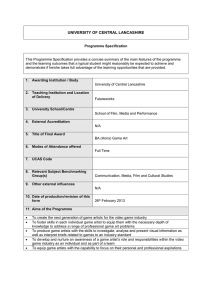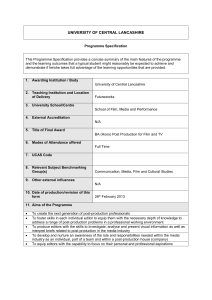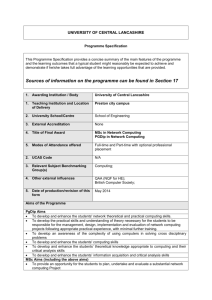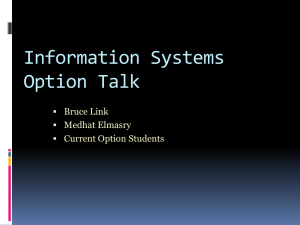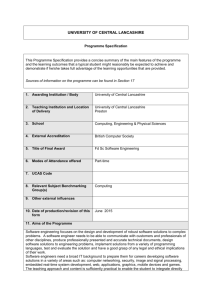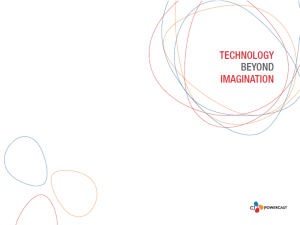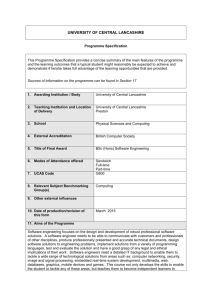ba_hons_3d_visual_effects - University of Central Lancashire
advertisement
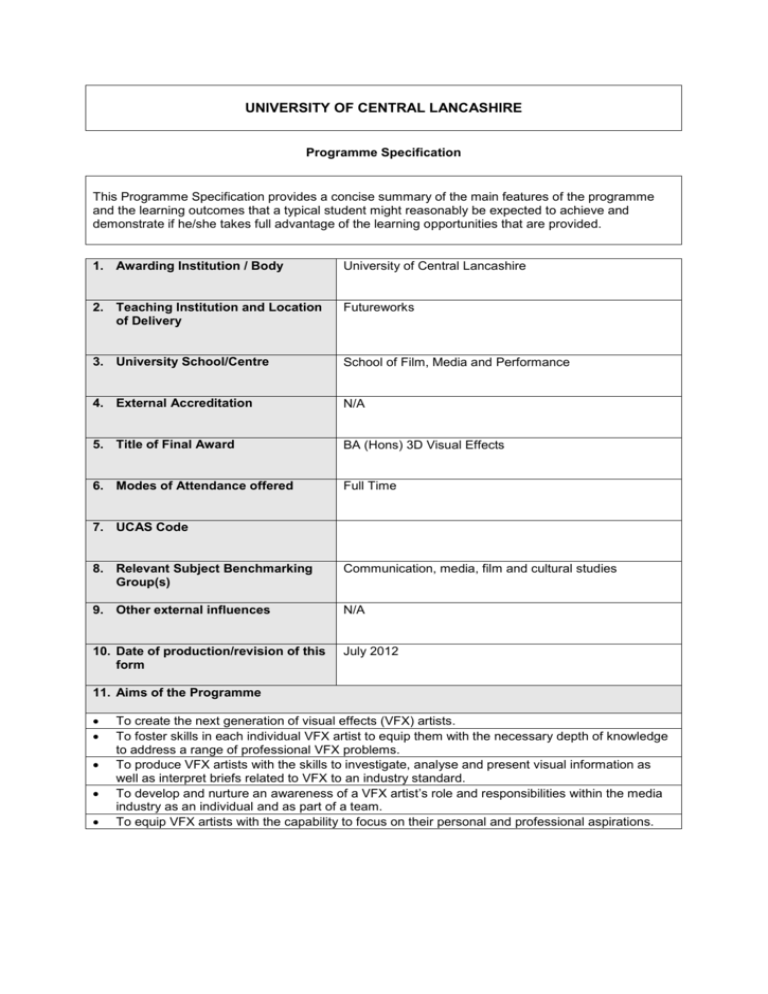
UNIVERSITY OF CENTRAL LANCASHIRE Programme Specification This Programme Specification provides a concise summary of the main features of the programme and the learning outcomes that a typical student might reasonably be expected to achieve and demonstrate if he/she takes full advantage of the learning opportunities that are provided. 1. Awarding Institution / Body University of Central Lancashire 2. Teaching Institution and Location of Delivery Futureworks 3. University School/Centre School of Film, Media and Performance 4. External Accreditation N/A 5. Title of Final Award BA (Hons) 3D Visual Effects 6. Modes of Attendance offered Full Time 7. UCAS Code 8. Relevant Subject Benchmarking Group(s) Communication, media, film and cultural studies 9. Other external influences N/A 10. Date of production/revision of this form July 2012 11. Aims of the Programme To create the next generation of visual effects (VFX) artists. To foster skills in each individual VFX artist to equip them with the necessary depth of knowledge to address a range of professional VFX problems. To produce VFX artists with the skills to investigate, analyse and present visual information as well as interpret briefs related to VFX to an industry standard. To develop and nurture an awareness of a VFX artist’s role and responsibilities within the media industry as an individual and as part of a team. To equip VFX artists with the capability to focus on their personal and professional aspirations. 12. Learning Outcomes, Teaching, Learning and Assessment Methods A. Knowledge and Understanding On completion of the programme students will be able to: A1. Use fundamental VFX theory to inform their practical work. A2. Use historical and contemporary developments to interpret the practice and significance of the VFX industry in society today. A3. Identify and select from a range of CGI techniques to inform their personal work-style. A4. Display a competence within a specialist area of VFX A5. Employ visual language in the creative process. Teaching and Learning Methods Knowledge and understanding is traditionally gained largely through lecturer input. Whilst lecturer input will be important on this programme a significant proportion of knowledge and, particularly, understanding is gained through student-generated learning, research, directed and self-selected learning, structured tasks and assignments, and project work. Tutorials will facilitate exchange of knowledge, exploration of subject boundaries and provide a forum for building on the knowledge base and enhancement of understanding. Assessment methods Knowledge and understanding is assessed using a variety of methods. The principal methods of assessment for this skill area will be: Essays Presentations, individual and group CGI Artefacts Projects Project Plans Storyboards Portfolios Showreel Formative assessment supported by tutor feedback will be employed throughout the programme and will aid the development of knowledge and understanding. Feedback will be a crucial component of summative assessments. B. Subject-specific skills On completion of the programme students will be able to: B1. B2. B3. B4. Develop an idea from a conception through to a final outcome. Generate and employ creative ideas to produce distinctive work. Use a variety of contemporary techniques to produce professional CGI artefacts. Employ professional practices and procedures to produce and present work. Teaching and Learning Methods For subject-specific skills the teaching and learning methods will focus on practical workshops, projects and self-learning, supported by teacher input and directed study. The challenge of developing creative skills will be addressed by cultivating a variety of creative techniques drawing on a critical appreciation of the visual and narrative heritage underpinning the visual effects world. Students will gain a working knowledge of creative possibilities, exploring their own creative potential in a critical and supportive environment. Assessment methods Subject-specific skills will be primarily assessed through practical outputs, specifically: CGI Artefacts Projects Project Plans Storyboards Showreels Authored Media Formative assessment supported by tutor feedback will be employed throughout the programme and will aid the development of subject-specific skills. Feedback will be a crucial component of summative assessments. C. Thinking Skills On completion of the programme students will be able to: C1. C2. C3. C4. C5. Research and interpret material and stimuli in order to synthesise informed ideas. Critically analyse and evaluate a variety of complex information. Formulate evidence-based arguments and engage in debate. Identify and solve a range of multifaceted problems. Synthesise and refine visual and verbal ideas and concepts as a part of the creative process. Teaching and Learning Methods Students develop thinking skills through the challenge of undertaking set tasks and assignments supported by significant tutor input throughout the programme. For example, research techniques are taught in contextual-based modules and then developed through completing assignments and receiving feedback on the results. Students will be closely supported in the process of synthesising ideas and concepts and translating them into creative artefacts. Assessment methods Assignments which primarily assess knowledge, understanding and subject-specific skills implicitly contain a thinking skills component; thus, every assignment will assess thinking skills to varying degrees. Formative assessment of thinking skills, supported by tutor feedback, will be employed throughout the programme. Feedback on written and oral assignments will include comment on the employment of thinking skills. D. Other skills relevant to employability and personal development On completion of the programme students will be able to: D1. Communicate complex ideas and arguments confidently and effectively using oral, visual and written methods. D2. Work successfully in teams and interact with others in a variety of professional contexts. D3. Implement time management techniques to plan and execute complex projects. D4. Perform critical self-analysis, identify skills gaps and plan personal development to maximise employment potential. Teaching and Learning Methods As this is a vocationally focused course employability skills are central to the whole student experience. The challenge for the programme delivery team is to ensure that the employability benefits of the subject-specific skills are complemented by the parallel development of personal skills such as communication and team working. This will be achieved through the design of tasks and assignments that demand skills beyond those that are technical and subject-based, and call for a broader personal skills set. Tutor input and feedback in a supportive context will help students to build on their positive traits and address gaps and weaknesses in their profile. Assessment methods The centrality of vocational skills throughout the programme results in all assessments being directly or indirectly related to employability and personal development. The assessment methods which are particularly significant are: Essays Personal Development Plans Reflective journals Presentations, individual and group Projects Digital Showreels Throughout the programme feedback on formative and summative assessments will help students develop their employability and personal development skills. 13. Programme Structures Level 6 Module Code DD3410 DD3420 DD3430 DD3411 DD3412 5 Module Title Visual Effects 3 Year 3 Visual Effects Project Personal & Professional Development 3D Modelling 3 Honours Project DD2410 DD2420 DD2430 DD2411 DD2412 Visual Effects 2 Year 2 Visual Effects Project Contemporary Visual Effects 3D Modelling 2 Post-Production & Motion Graphics 4 DD1410 Visual Effects 1 DD1420 Year 1 Visual Effects Project DD1430 History of Visual Effects DD1411 3D Modelling 1 DD1412 Content Creation for VFX 15. Personal Development Planning 14. Awards and Credits Credit rating 20 20 20 20 40 Bachelor Honours Degree Requires 360 credits including a minimum of 120 at Level 5 or above and 120 at Level 6 Bachelor Degree Requires 320 credits including a minimum of 120 at Level 5 or above and 80 at Level 6 20 20 20 20 40 Diploma of Higher Education Requires 240 credits including a minimum of 120 at Level 5 or above 20 20 20 20 40 Certificate of Higher Education Requires 120 credits at Level 4 or above Introduced at induction, the purpose and process of PDP will be explained and students will be provided with a PDP template. At each level one module is identified as the primary vehicle for addressing PDP. Within the identified modules tutors will discuss the ongoing PDP process on a oneto-one basis, helping students to build on their strengths and identify and address gaps in their skill set. The Level 6 module “Personal & Professional Development” specifically requires students to research and use analytical techniques relating to personal development and employability and develops a high-level approach to Personal Development Planning. Throughout the learning process students will be encouraged to identify and evaluate their personal development activity. All practical assessments employ reflective journals which will assist students in this process. 16. Admissions criteria Programme Specifications include minimum entry requirements, including academic qualifications, together with appropriate experience and skills required for entry to study. These criteria may be expressed as a range rather than a specific grade. Amendments to entry requirements may have been made after these documents were published and you should consult the University’s website for the most up to date information. Students will be informed of their personal minimum entry criteria in their offer letter. Applicants are required to hold: A minimum of 5 GCSE passes at Grade C or above including Maths and English (or equivalent) 240 to 300 UCAS points at A2 (or equivalent) Applicants must also: Attend an interview to assess their commitment and motivation. 17. Key sources of information about the programme Course factsheet Student course handbook Futureworks prospectus Futureworks website 18. Curriculum Skills Map Please tick in the relevant boxes where individual Programme Learning Outcomes are being assessed Level Module Code Module Title Core (C), Compulsory (COMP) or Option (O) Knowledge and understanding LEVEL 4 LEVEL 5 LEVEL 6 A1 Note: DD3410 Visual Effects 3 COMP DD3420 Year 3 Visual Effects Project COMP DD3430 Personal & Prof. Development COMP DD3411 3D Modelling 3 COMP DD3412 Honours Project COMP DD2410 Visual Effects 2 COMP DD2420 Year 2 Visual Effects Project COMP DD2430 Contemporary Visual Effects COMP DD2411 3D Modelling 2 COMP DD2412 Post-prod. & Motion Graphics COMP X DD1410 Visual Effects 1 COMP X DD1420 Year 1 Visual Effects Project COMP X DD1430 History of Visual Effects COMP DD1411 3D Modelling 1 COMP X DD1412 Content Creation for VFX COMP X A2 X A3 X Programme Learning Outcomes Subject-specific Skills A4 A5 B1 B2 B3 X X X X X X X X X X X X X Thinking Skills B4 C1 C2 C3 X X X X X X X X X X X X X X X X X X X X X X X X X X X X X X X X X X X X X X X X X X X X X X X X X X X X X X X X X X X X X X X X X X D1 D2 D3 X X X X X X X X X X X X X X X X X X D4 X X X X X X X X X X X X X X X X X X X X X X C5 X X X X X X X C4 X X X Other skills relevant to employability and personal development X X X X X X X X Mapping to other external frameworks, e.g. professional/statutory bodies, will be included within Student Course Handbooks X X X
